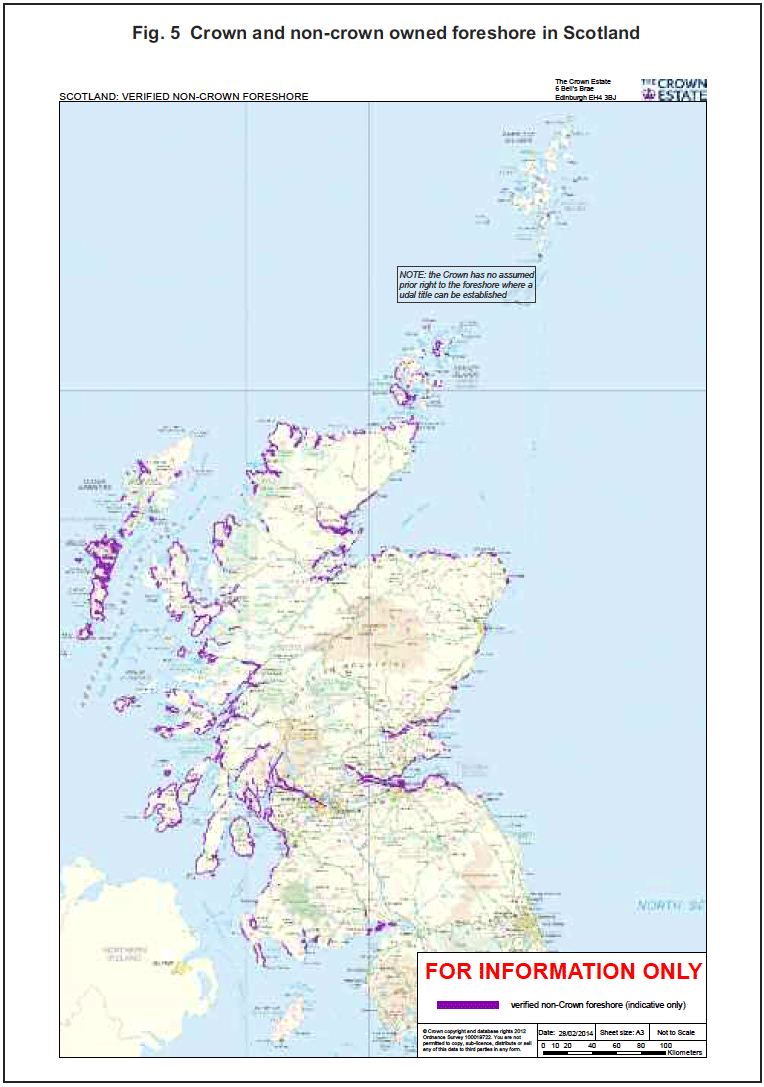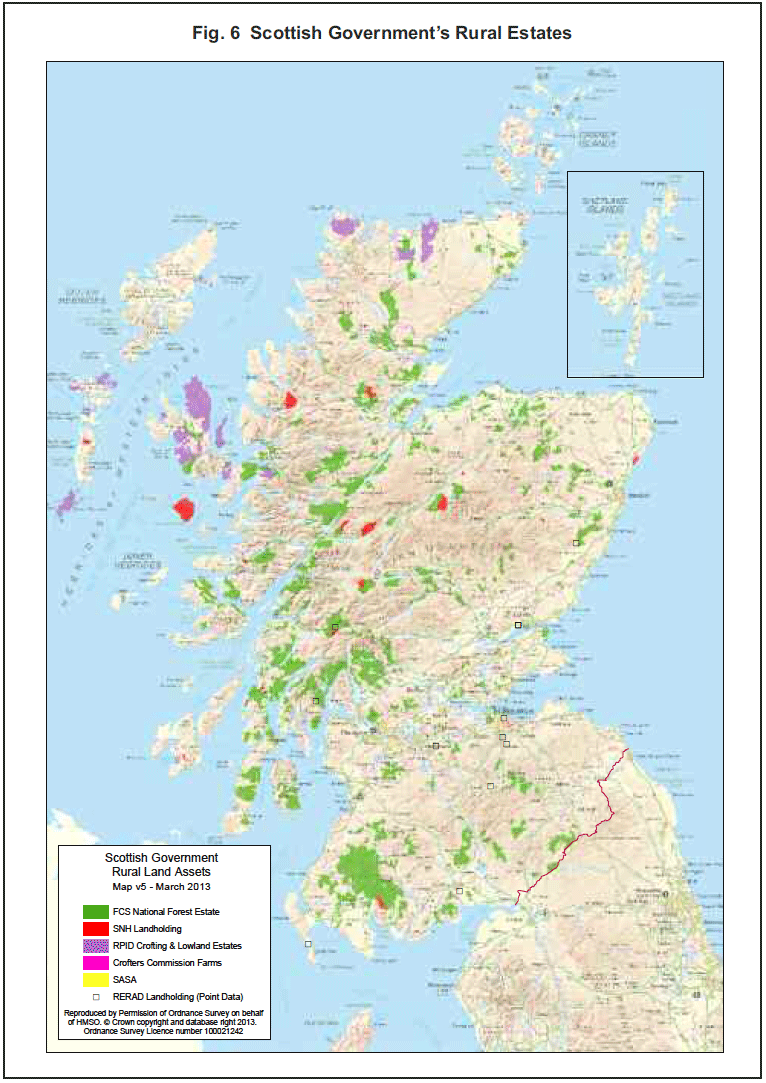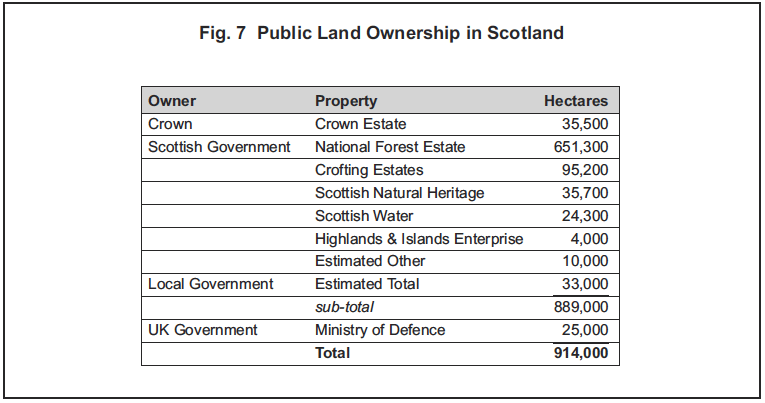The land of Scotland and the common good: report
The final report of the Land Reform Review Group.
Section 9 - Extent of Public Land
The Crown
7 As described in Section 1, Scotland is a sovereign territory and the Crown has a separate and different legal and constitutional identity in Scotland under Scots law, compared to the Crown in the rest of the UK under English law. Correspondingly, the property rights vested in the Crown in Scots law are different from those in the rest of the UK and belong to Scotland.
8 This is important because Crown property rights are a major component of land ownership in Scotland. Most importantly, the ownership of Scotland's territorial seabed is vested in the Crown in Scots law. The extent of this area and of the rights associated with it, have both increased substantially in the last 50 years. These expansions have resulted from internationally agreed United Nations Conventions on the Laws of the Sea being enacted into UK law. As a result of these, Scotland's territorial boundary has expanded from 3 to 12 nautical miles from the coastline, and additional rights have also been vested in the Crown over Scotland's adjoining continental shelf area out to 200 nautical miles. [1]
9 Approximately 52% of Scotland's total territorial area is seabed and very nearly all of this area is still owned by the Crown (See Section 1). The limited exceptions to this all consist of areas adjoining the coastline, where the Crown has granted out the ownership historically or more recently sold it. These areas include, for example, some statutory harbour authorities which own some or all the seabed within their harbours (for example, Aberdeen) or areas acquired for infra-structure developments (for example, land under the columns for the Forth Road Bridge). The largest single exception to the Crown's ownership of Scotland's seabed is a rectangular area extending into the Firth of Forth from the Port of Leith. [2]
10 The Crown also still owns around 50% of the 18,000 km length of Scotland's foreshore ( Fig.5). The foreshore is defined in Scots law as the area of shore between the high and low water marks of ordinary spring tides, and it forms the boundary between the marine and terrestrial halves of Scotland's land area. The exceptions to the Crown's ownership of the foreshore are of two main types. Firstly, there is no Crown foreshore in the Northern Isles under udal tenure, where ownership of the foreshore goes with the ownership of the adjoining land. Secondly, there are the many parts of the rest of Scotland's foreshore that have been acquired from the Crown by other land owners, much of it in the 19th century.
11 The ownership of Scotland's seabed and of much of its foreshore are ancient possessions of the Crown, where the legal presumption is that an area of seabed or foreshore is owned by the Crown unless there is evidence that it has been acquired by someone else. The Crown's ownership of Scotland's seabed and much of its foreshore are both managed by the Crown Estate Commissioners ( CEC).
12 By contrast with the marine environment and as described further in Section 12, the Crown now holds virtually no land in the terrestrial half of Scotland as ancient possessions. The Crown is, however, still a significant land owner due to modern acquisitions of land on behalf of the Crown in the 20th century. There are four rural estates totalling 35,450 ha. [3] Over 75% of this area consists of the estates of Glenlivet (22,350 ha) and Fochabers (4,850 ha) in Banff and Moray. These were acquired in 1937 by the then Commissioners of Crown Lands due to concern at the time about the local socio-economic impact of the break up of the Duke of Richmond and Gordon's extensive estates in Strathspey. The other two estates, which were both acquired in the 1960s as investments, are Applegirth (6,850 ha) in Dumfries & Galloway and Whitehill (1,400 ha) in Midlothian. All these estates are managed by the CEC.
The Scottish Government
13 The Scottish Government owns land for a wide range of purposes as part of delivering public policy, and also owns this land in a variety of ways. With the majority of the land, the title is vested in Scottish Ministers and may either be managed directly by the Scottish Government or through various Scottish non-departmental public bodies. Alternatively, with some land, the title is held directly by the public body managing the land. There are also other arrangements, for example, Caledonian Maritime Assets Ltd, which is an independent company wholly owned by Scottish Ministers and which owns the infra-structure for life-line ferry services in a number of harbours.
14 The Scottish Government carried out an asset management review of the land and property owned by the Government five years ago, including a separate review of rural land owned by the Government. [4] In addition, there is the on-going work by the Scottish Futures Trust ( SFT), another independent company wholly owned by Scottish Ministers, on the ownership and management of Scottish Government property. [5] Both the Scottish Government's review and SFT's work identify the need for the Government to have improved central information on the land and buildings directly or indirectly under its management.
15 The Review Group, for its part, was surprised that there seems to be no readily accessible, central account of the land owned by the Scottish Government in its various guises. The information is held in various internal Scottish Government registers and by a range of other Scottish public bodies and much of it is not readily accessible. However, in this context, the Group's interest was only in the broad scale and scope of Scottish Government ownership.
16 The main components of the land owned by the Scottish Government in rural Scotland are shown in Fig. 6 and in Fig. 7. The two largest areas are the National Forest Estate, which is discussed in Section 13, and the Scottish Government's crofting estates, which are discussed in Section 26. The Review Group was able to find out only limited information on the extent of other land owned by Scottish Ministers and managed by various parts of the Scottish Government, such as Historic Scotland, Transport Scotland and others. The Group has estimated this to be around 10,000 ha.
17 The Scottish non-departmental public bodies listed in Fig. 7 all hold title to the land in their own name. The Scottish Natural Heritage land is principally National Nature Reserves, while the Scottish Water land is catchment areas to protect important water supply sources. With Highlands and Islands Enterprise, the land mainly consists of the Orbost Estate (2,230 ha) on Skye and Cairngorm Mountain Estate (1,419 ha), which includes the ski slope area.
Other Public Land
18 The other key component of public land ownership in Scotland is the property owned at local government level by Scotland's 32 Local Authorities. These Local Authorities need, like the Scottish Government, to own and manage land for a wide range of purposes.
19 There appears no readily accessible information on the extent of land held by the Local Authorities. While the Local Authorities will have their own records, no overall information on their holdings appears available on their websites. Therefore, for the limited purpose of providing an indication of the order of magnitude of the extent of land owned by local authorities, the Group has used an existing estimate. [6]
20 The other form of public land in Fig. 7 is land owned in Scotland by the UK Government, which very largely consists of land managed by the Ministry of Defence.
Overall Amount
21 Over half of Scotland's territorial land area is public land by virtue of the Crown's ownership of Scotland's territorial seabed, while around half the length of Scotland's foreshore is also still public land owned by the Crown.
22 In considering the terrestrial half of Scotland, the totals in Fig. 7 indicate that approximately 889,000 ha. or 11% of Scotland's land area of 8 million ha., is owned by the Scottish Government and local authorities.
23 The two largest components of the Scottish Government's land and therefore the great majority of public land in rural Scotland, both result very largely from acquisitions during the first half of the 20th century. The crofting estates date from the Government land settlement programmes from the end of the 19th century until the 1950s. The build up from 1919, of the land managed by the Forestry Commission that now makes up Scotland's National Forest Estate had largely ended by 1970s. The growth of public land ownership during the first half of the 20th century, remains one of the few major changes to have significantly affected the pattern of land ownership in rural Scotland during the last 100 years.
24 During the last 40 years, the overall proportion of public land ownership compared to private land ownership seems to have remained broadly similar. [7] The pattern of private land ownership in the remaining nearly 90% of rural Scotland is considered later in Section 24 of this Report.
Public Asset Registers
25 The main issue in this Section is the relatively limited information available on public land ownership in Scotland. The Review Group considers there to be a lack of clear and accessible information on the land and buildings owned by the Scottish Government and local authorities, particularly in urban areas.
26 The practical benefits to Scotland's economy of having the information available were referred to in Section 4 on Land Registration. The wider community benefits in improving the information available were also reflected in the "overwhelming support" for the proposal in the Scottish Government's consultation in 2013 on the Community Empowerment and Renewal Bill, that all public sector authorities should be required to make their asset registers available to the public (question 27).
27 The Scottish Government and local authorities are already required to keep asset registers and the Group considers that the only debate should be about the level of information about properties that should be made publicly available. The Group considers that the Scottish Government should have a central, online source of public information about Government properties, through which more detailed registers can be accessed about the properties managed by different parts of Government and other Scottish public bodies. The Group also considers that each local authority should have a publicly accessible online register or schedule of the properties owned and managed by the authority.
28 The Review Group considers that information on the properties in Scotland owned by the Scottish Government, local authorities and other public bodies, should be more readily available. The Group recommends that the Scottish Government, local authorities and other public bodies in Scotland should publish online property registers that are publicly accessible.
Contact
There is a problem
Thanks for your feedback


